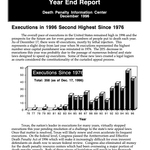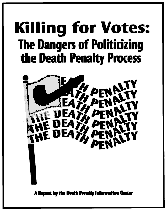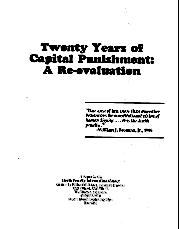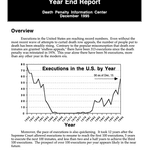DPI Reports
Below are reports released by the Death Penalty Information Center since its inception, covering subjects such as race, innocence, politicization, costs of the death penalty, and more. When opening a report, please allow the report page to load fully before selecting links to sections or footnotes. Most of these reports are also available in printed form from DPIC. For a copy of one of these reports, e‑mail DPI. For bulk orders, please download our Resource Order Form.
Reports are separated into Year End Reports, In-Depth Reports, and Special Reports. In-Depth Reports are DPI’s signature long, thorough reports on major death-penalty issues. These include “The 2% Death Penalty,” examining geographic arbitrariness in capital punishment, and “Behind the Curtain,” covering secrecy in the death penalty system. Special Reports are shorter, and typically address a specific event or question. These include DPI’s explanation of the 2017 spate of executions that were scheduled in Arkansas, and our analysis of the largest number of executions performed on a single day.
Reports: 61 — 65
Dec 17, 1996
The Death Penalty in 1996: Year End Report
The overall pace of executions in the United States remained high in 1996 and the prospects for the future are for even greater numbers of people put to death each year. As of December 17, there were 45 executions, mostly by lethal injection. This represents a slight drop from last year when 56 executions represented the highest number since capital punishment was reinstated in 1976. The 20% decrease in executions this year was probably due to the passage of…
Read MoreOct 18, 1996
Killing for Votes: The Dangers of Politicizing the Death Penalty Process
– U.S. Supreme Court Justice John Paul Stevens, 1996…
Read MoreJun 01, 1996
Twenty Years of Capital Punishment: A Re-Evaluation
–William J. Brennan, Jr., retired Supreme Court Justice, 1996…
Read MoreDec 15, 1995
The Death Penalty in 1995: Year End Report
Executions in the United States are reaching record numbers. Even without the most recent wave of attempts to curtail death row appeals, the number of people put to death has been steadily rising. Contrary to the popular misconception that death row inmates are granted“endless appeals,” there have been 313 executions since the death penalty was reinstated in 1976. This year alone there have been 56 executions, more than any other year in…
Read MoreOct 01, 1995
With Justice for Few: The Growing Crisis in Death Penalty Representation
– Former U.S. Supreme Court Justice Harry A. Blackmun…
Read More



